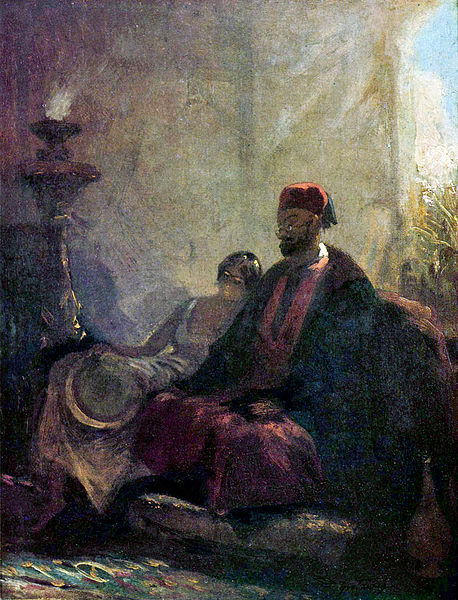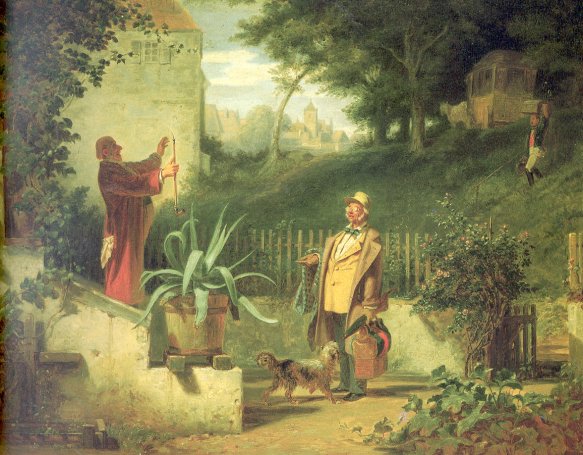
施皮茨韦格 (1808年2月5日-1885年9月23日)为德国浪漫主义画家以及诗人。也是比德迈风格画家中最具代表性的人物。
Carl Spitzweg was born on February 5th, 1808 in Munich. After his school-days he first worked as a pharmacy trainee, before - from 1830 until 1832 - studying pharmacy at the university of Munich. During his years of study he simultaneously worked as a chemist's assistant in Straubing.
As far as his artistic career is concerned, Spitzweg is a pure self-taught man. At first he schooled himself by copying Flemish masters in the "Alte Pinakothek". Additional inspiration he got from friends like Christian Morgenstern and others.
Spitzweg gathered his first artistic experiences in the 30s and 40s as a sketch-artist for satiric magazines ("Nürnberger Trichter", "Fränkische Blätter").
Carl Spitzweg:
German Painter, 1808-1885 German painter. He trained (1825-8), at his father's insistence, as a pharmacist, by 1829 becoming manager of a pharmacy in the Straubing district of Munich. From 1830 to 1832 he made advanced studies in pharmacy, botany and chemistry at the University of Munich, passing his final examination with distinction. On receiving a large legacy in 1833, which made him financially independent, he decided to become a painter. He had drawn since the age of 15 and had frequented artistic circles since the late 1820s; but he had no professional training as a painter. He learnt much from contacts with young Munich landscape painters such as Eduard Schleich the elder and produced his first oil paintings in 1834. In 1835 he became a member of the Munich Kunstverein but left two years later due to disappointment over the reception of the first version of the Poor Poet (1837; Munich, Neue Pin.; second version 1839; Berlin, Neue N.G.), a scene of gently humorous pathos that has since become his most celebrated work. Spitzweg's decision to leave the Kunstverein, however, was also encouraged by his first successful attempts to sell his paintings independently. In 1839 he travelled to Dalmatia, where he made sketches that he used for many later works on Turkish themes (e.g. the Turkish Coffee House, c. 1860; Munich, Schack-Gal.). From the 1840s he travelled regularly, usually with his close friend, the painter Schleich, both within Bavaria and to Austria and Switzerland and also to the Adriatic coast, especially to Trieste. 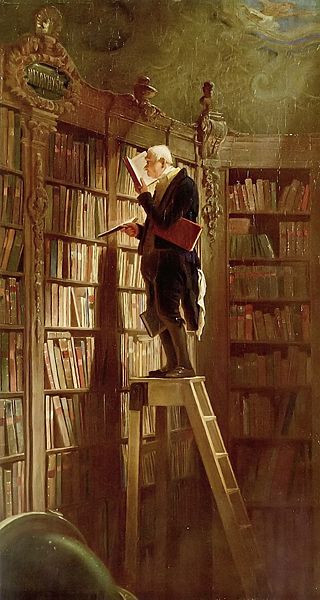
书虫 The Bookworm, 1850.,Museum Georg Schäfer
The Sunday Walk, a gently ironic portrayal of a petit-bourgeois family in the countryside,
typical Biedermeier style painting by Carl Spitzweg, 1841
The Poor Poet, 1839. Neue Pinakothek
Im Harem
Art et science (v. 1880)

Carl Spitzweg "The couple at the bank (stroller having a rest)"
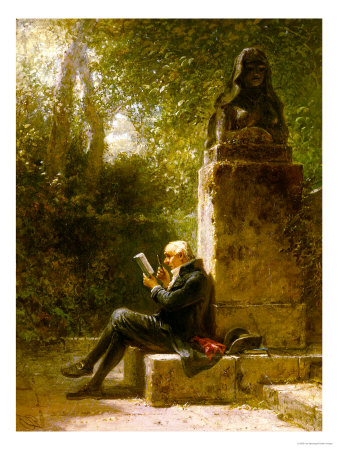

Der Schmetterlingsjäger
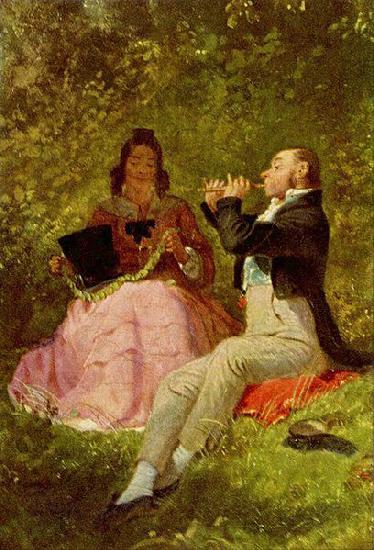
Ein Solo,

Badende Nymphe
Carl Spitzweg "Knitting Hermit"
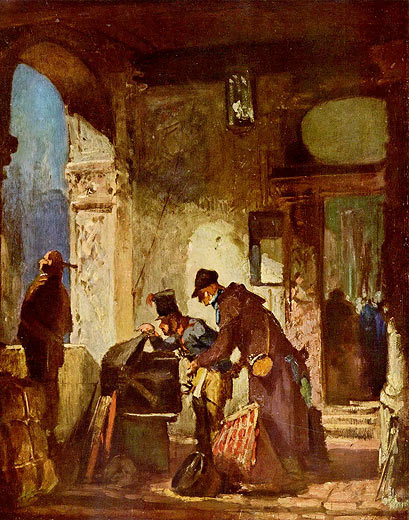
"Päpstliche Zollwache" ("Papal customs", 1880).
Duty - Examination of Passengers Luggage 

Schulkinder im Wald, Sammlung Georg Schäfer
Schoolchildren in the Woodland

Disputierende Mönche, 1860, Sammlung Georg Schäfer
Disputing monks
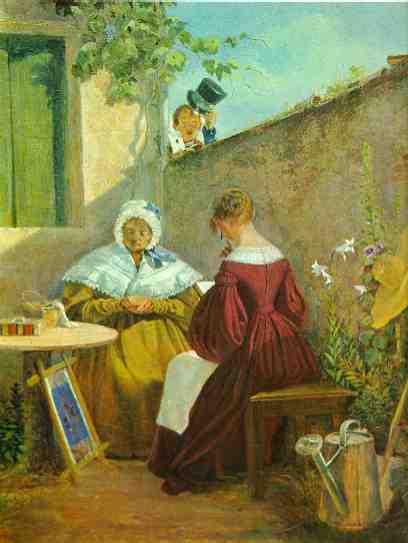
love letter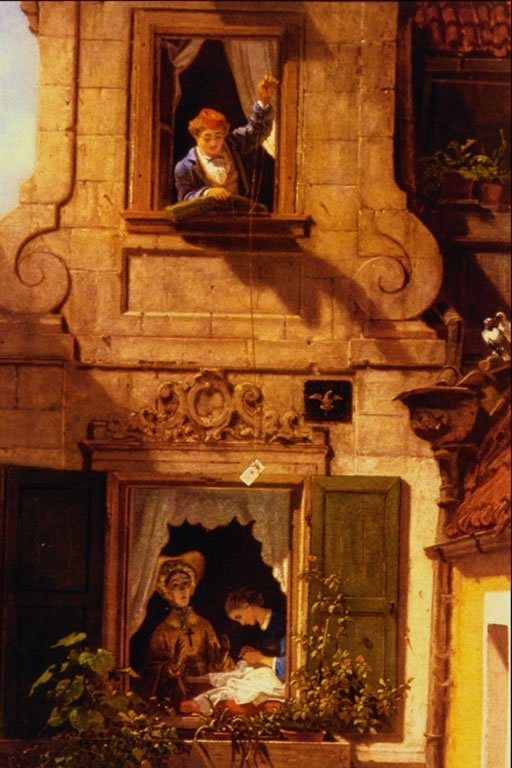
The Intercepted Love Letter Carl Spitzweg
http://www.historylink101.com/art/CarlSpitzweg/357060.html
施魏因富特格奥尔格·舍费尔博物馆
格奥尔格·舍费尔博物馆(Museum Georg Schäfer)位于施魏因富特(Schweinfurt),1999年起对外开放,在3600平方米的展览面积上,它展出了19世纪德语区的珍贵艺术品,是同类私人收藏馆中馆藏最丰富、最重要的之一。这里展出18世纪初到20世纪初的绘画和纸本作品,它们呈现出这一时期不同艺术流派的全貌——从洛可可晚期到古典主义和浪漫派,再到印象主义和分离画派。收藏中最古老的图画有雅努阿里乌斯·齐克(Januarius Zick)1760年完成的“农村的田园风光(Bäuerliches Idyll)”。馆藏水准很高,这基于它收藏了重要艺术家的一流单品和作品组合以及最新发现的不太著名的大师们的画作。
The Museum Georg Schäfer is a German art museum in Schweinfurt, Bavaria, Germany. Based on the private art collection of German industrialist Georg Schäfer, the museum primarily collects 19th-century paintings by artists from German-speaking countries.
